Multilayered Balanced Dual-Band Bandpass Filter Based on Magnetically Coupled Open-Loop Resonators with Intrinsic Common-Mode Rejection
Abstract
1. Introduction
2. Proposed Structure: Analysis and Design Methodology
2.1. Analysis of the Structure
2.2. Design Methodology
- If middle layer resonators length is kept constant, changing top layer resonators length only affects the upper band center frequency, with very slight effect on the lower band center frequency.
- If top layer resonators length is kept constant, changing middle layer resonators length only affects the lower band center frequency with negligible effect on the upper band center frequency.
- First, resonator dimensions must be obtained in order to fit their resonance frequencies to the desired passband center frequencies. Since these specific resonators are half-wavelength open loop resonators, their resonance frequencies are mainly determined by their lengths, which can be easily obtained by using well known equations [45] or with the help of the electromagnetic simulator.
- Next, the fractional bandwidth of each differential passband is set to the desired one by properly adjusting the values of and .
- Finally, the matching level is adjusted by setting the values of and .
3. Results
3.1. Prototype Example
3.2. Experimental Results
4. Discussion
- Filter size. In terms of electrical size, the proposed filter is very competitive. Indeed, is one of the smallest in the table (0.035 , being the guided wavelength at the center of the lower transmission band, when the average size for those presented in Table 1 is 0.184 ). There are only two designs smaller than the one in this contribution [40,42], but it should be taken into account that one of the main advantages of our filter lies on its simplicity. Size reduction through optimization of the geometry of the resonators would be possible but has not been attempted.
- Fractional bandwidth. Our design confers the designer total and independent control on the bandwidth of the two passbands. For our specifications and requirements, the filter perfectly covers both the GPS band and the Wi-Fi band, so there are no issues on this regard. If we look at the results obtained in the considered literature, the average fractional bandwidth is 8.74% (first band) and 5.72% (second band). Both values are very close to those reported in this work. These values can still be increased a little further by adjusting the values of the separation between resonators, as it can be seen in Figure 7 in the paper. Note that using practicable values of such separations, our design would be able to compete with those with the highest values of FBW reported in Table 1.
- Insertion loss. The average IL of the designs presented in Table 1 are 1.63 dB and 2.25 dB for the first and second passbands, respectively. Note that the measured IL values for our design is, once again, competitive with the state-of-the-art, providing one the lowest values of IL for the first passband.
- Band-to-band isolation. The best way of obtaining good band-to-band isolation is to introduce one or more transmission zeros between the passbands. This is not the case in the presented design. Nevertheless, the IL in the frequency region between passbands reaches 36 dB, this being a very good value for many applications. Ten of the designs included in Table 1 exhibit transmission zeroes between passband. Thus, this point could be considered the main drawback of the proposed filter topology and adding elements to introduce transmission zeros would result into a significant improvement, provided the other relevant features of the filter are not significantly affected.
- Common-mode Rejection Ratio (CMRR). The average CMRR values of the filters in Table 1 for the first and second differential passbands is 37.95 dB and 32.55 dB, respectively. These values are very close to the ones achieved with the proposed design. The advantage of our proposal is that this high level of CMRR is inherent to the coupling scheme and no additional components have to be added to enhance the CM suppression (such as lumped inductors, capacitors or resistors, additional CM rejection stages, additional open-circuit stubs, etc.). The introduction of these elements usually entails disadvantages (increase in complexity and the need of reaching a trade-off to avoid the deterioration of other filter parameters).
5. Conclusions
Author Contributions
Funding
Conflicts of Interest
References
- Eisenstant, W.R.; Stengel, B.; Thompson, B.M. Microwave Differential Circuit Design Using Mixed-Mode S-Parameters; Artech House: Boston, MA, USA, 2006. [Google Scholar]
- Martin, F.; Zhu, L.; Hong, J.; Medina, F. Balanced Microwave Filters; John Wiley & Sons: New York, NY, USA, 2018. [Google Scholar]
- Xia, B.; Wu, L.S.; Mao, J.F. A new balanced-to-balanced power divider/combiner. IEEE Trans. Microw. Theory Tech. 2012, 60, 2791–2798. [Google Scholar] [CrossRef]
- Xia, B.; Wu, L.S.; Ren, S.W.; Mao, J.F. A balanced-to-balanced power divider with arbitrary power division. IEEE Trans. Microw. Theory Tech. 2013, 61, 2831–2840. [Google Scholar] [CrossRef]
- Wu, L.S.; Guo, Y.X.; Mao, J.F. Balanced-to-balanced Gysel power divider with bandpass filtering response. IEEE Trans. Microw. Theory Tech. 2013, 61, 4052–4062. [Google Scholar] [CrossRef]
- Feng, W.; Zhu, H.; Che, W.; Xue, Q. Wideband in-phase and out-of-phase balanced power dividing and combining networks. IEEE Trans. Microw. Theory Tech. 2014, 62, 1192–1202. [Google Scholar] [CrossRef]
- Zhou, Y.; Deng, H.W.; Zhao, Y. Compact balanced-to-balanced microstrip diplexer with high isolation and common-mode suppression. IEEE Microw. Wirel. Compon. Lett. 2014, 24, 143–145. [Google Scholar] [CrossRef]
- Hsiao, C.Y.; Wu, T.L. A novel dual-function circuit combining high-speed differential equalizer and common-mode filter with an additional zero. IEEE Microw. Wirel. Compon. Lett. 2014, 24, 617–619. [Google Scholar] [CrossRef]
- Naqui, J.; Fernández-Prieto, A.; Durán-Sindreu, M.; Mesa, F.; Martel, J.; Medina, F.; Martín, F. Common mode suppression in microstrip differential lines by means of complementary split ring resonators: Theory and applications. IEEE Trans. Microw. Theory Tech. 2012, 60, 3023–3034. [Google Scholar] [CrossRef]
- Olvera-Cervantes, J.L.; Corona-Chávez, A. Microstrip balanced bandpass filter with compact size, extended-stopband and common-mode noise suppression. IEEE Microw. Wirel. Compon. Lett. 2013, 23, 530–532. [Google Scholar] [CrossRef]
- Horestani, A.K.; Durán-Sindreu, M.; Naqui, J.; Fumeaux, C.; Martín, F. S-shaped complementary split ring resonators and their application to compact differential bandpass filters with common-mode suppression. IEEE Microw. Wirel. Compon. Lett. 2014, 24, 149–151. [Google Scholar] [CrossRef]
- Wu, X.H.; Chu, Q.X.; Qiu, L.L. Differential wideband bandpass filter with high-selectivity and common-mode suppression. IEEE Microw. Wirel. Compon. Lett. 2013, 23, 644–646. [Google Scholar] [CrossRef]
- Lin, L.; Bao, J.; Du, J.J.; Wang, Y.M. Differential wideband bandpass filters with enhanced common-mode suppression using internal coupling techniquen. IEEE Microw. Wirel. Compon. Lett. 2014, 24, 300–302. [Google Scholar]
- Xu, X.; Wang, J.; Zhu, L. A new approach to design differential-mode bandpass filters on SIW structure. IEEE Microw. Wirel. Compon. Lett. 2013, 23, 635–637. [Google Scholar] [CrossRef]
- Feng, W.; Che, W. Novel wideband differential bandpass filters based on T-shaped structure. IEEE Trans. Microw. Theory Tech. 2012, 60, 1560–1568. [Google Scholar] [CrossRef]
- Wu, X.H.; Chu, Q.X. Compact differential ultra-wideband band-pass filter with common-mode suppression. IEEE Microw. Wirel. Compon. Lett. 2012, 22, 456–458. [Google Scholar] [CrossRef]
- Lu, Y.J.; Chen, S.Y.; Hsu, P. A differential-mode wideband bandpass filter with enhanced common-mode suppression using slotline resonator. IEEE Microw. Wirel. Compon. Lett. 2012, 22, 503–505. [Google Scholar] [CrossRef]
- Vélez, P.; Naqui, J.; Fernández-Prieto, A.; Durán-Sindreu, M.; Bonache, J.; Martel, J.; Medina, F.; Martín, F. Differential bandpass filter with common-mode suppression based on open split ring resonators and open complementary split ring resonators. IEEE Microw. Wirel. Compon. Lett. 2013, 23, 22–24. [Google Scholar] [CrossRef]
- Feng, W.; Che, W.; Ma, Y.; Xue, Q. Compact wideband differential bandpass filters using half-wavelength ring resonator. IEEE Microw. Wirel. Compon. Lett. 2013, 23, 81–83. [Google Scholar] [CrossRef]
- Shi, J.; Shao, C.; Chen, J.X.; Lu, Q.Y.; Peng, Y.; Bao, Z.H. Compact low-loss wideband differential bandpass filter with high common-mode suppression. IEEE Microw. Wirel. Compon. Lett. 2013, 23, 480–482. [Google Scholar] [CrossRef]
- Wu, C.H.; Wang, C.H.; Chen, C.H. Novel balanced coupled-line bandpass filters with common-mode noise suppression. IEEE Trans. Microw. Theory Tech. 2007, 55, 287–295. [Google Scholar] [CrossRef]
- Wu, C.H.; Wang, C.H.; Chen, C.H. Stopband-extended balanced bandpass filter using coupled stepped-impedance resonators. IEEE Microw. Wirel. Compon. Lett. 2007, 17, 507–509. [Google Scholar] [CrossRef]
- Lin, S.C.; Yeh, C.Y. Stopband-extended balanced filters using both λ/4 and λ/2 SIRs with common mode suppression and improved passband selectivity. Prog. Electromagn. Res. 2012, 128, 215–228. [Google Scholar] [CrossRef][Green Version]
- Shi, J.; Chen, J.; Tang, H.; Zhou, L. Differential bandpass filter with high common-mode rejection ratio inside the differential-mode passband using controllable common-mode transmission zero. In Proceedings of the 2013 IEEE International Wireless Symposium (IWS), Beijing, China, 14–18 April 2013. [Google Scholar] [CrossRef]
- Wang, H.; Tam, K.W.; Ho, S.K.; Kang, W.; Wu, W. Short-ended self-coupled ring resonator and its application for balanced filter design. IEEE Microw. Wirel. Compon. Lett. 2014, 24, 312–314. [Google Scholar] [CrossRef]
- Fernández-Prieto, A.; Lujambio, A.; Martel, J.; Medina, F.; Mesa, F.; Boix, R. Simple and Compact Balanced Bandpass Filters Based on Magnetically Coupled Resonators. IEEE Trans. Microw. Theory Tech. 2015, 63, 1843–1853. [Google Scholar] [CrossRef]
- Shi, J.; Xue, Q. Balanced Bandpass Filters Using Center-Loaded Half-Wavelength Resonators. IEEE Trans. Microw. Theory Tech. 2010, 58, 970–977. [Google Scholar]
- Shi, J.; Xue, Q. Dual-Band and Wide-Stopband Single-Band Balanced Bandpass Filter With High Selectivity and Common-Mode Suppression. IEEE Trans. Microw. Theory Tech. 2010, 58, 2204–2212. [Google Scholar] [CrossRef]
- Guo, X.; Zhu, L.; Wu, W. Balanced Wideband/Dual-Band BPFs on a Hybrid Multimode Resonator with Intrinsic Common-Mode Rejection. IEEE Trans. Microw. Theory Tech. 2016, 64, 1997–2005. [Google Scholar] [CrossRef]
- Gómez-García, R.; Muñoz-Ferreras, J.-M.; Feng, W.; Psychogiou, D. Balanced Symmetrical Quasi-Reflectionless Single-and Dual-Band Bandpass Planar Filters IEEE Microw. Wirel. Compon. Lett. 2018, 28, 798–800. [Google Scholar] [CrossRef]
- Fernández-Prieto, A.; Martel, J.; Medina, F.; Mesa, F.; Qian, S.; Hong, J.; Naqui, J.; Martín, F. Dual-Band Differential Filter using Broadband Common-Mode Rejection Artificial Transmission Line. Prog. Electromagn. Res. 2013, 139, 779–797. [Google Scholar] [CrossRef]
- Bagci, F.; Fernández-Prieto, A.; Lujambio, A.; Martel, J.; Bernal, J.; Medina, F. Compact Balanced Dual-Band Bandpass Filter Based on Modified Coupled-Embedded Resonators. IEEE Microw. Wirel. Compon. Lett. 2017, 27, 31–33. [Google Scholar] [CrossRef]
- Shi, J.; Xue, Q. Novel Balanced Dual-Band Bandpass Filter Using Coupled Stepped Impedance-Resonators. IEEE Microw. Wirel. Compon. Lett. 2010, 20, 19–21. [Google Scholar]
- Lee, C.H.; Hsu, C.I.G.; Hsu, C.C. Balanced Dual-Band BPF with Stub-Loaded SIRs for Common-Mode Suppression. IEEE Microw. Wirel. Compon. Lett. 2010, 20, 70–72. [Google Scholar] [CrossRef]
- Wang, K.; Zhu, L.; Wong, S.W.; Chen, D.; Guo, Z.C. Balanced dual-band BPF with intrinsic common-mode suppression on double-layer substrate. Electron. Lett. 2015, 51, 705–707. [Google Scholar] [CrossRef]
- Cho, Y.H.; Yun, S.W. Design of Balanced Dual-Band Bandpass Filters Using Asymmetrical Coupled Lines. IEEE Trans. Microw. Theory Tech. 2013, 61, 2814–2820. [Google Scholar] [CrossRef]
- Li, P.; Chu, H.; Zhao, D.; Chen, R.S. Compact Dual-Band Balanced SIW Bandpass Filter With Improved Common-Mode Suppression. IEEE Microw. Wirel. Compon. Lett. 2017, 27, 347–349. [Google Scholar] [CrossRef]
- Yang, L.; Choi, W.W.; Tam, K.W.; Zhu, L. Balanced Dual-Band Bandpass Filter With Multiple Transmission Zeros Using Doubly Short-Ended Resonator Coupled Line. IEEE Microw. Wirel. Compon. Lett. 2015, 63, 2225–2232. [Google Scholar] [CrossRef]
- Wei, F.; Guo, Y.J.; Qin, P.Y.; Shi, X.W. Compact Balanced Dual- and Tri-band Bandpass Filters Based on Stub Loaded Resonators. IEEE Microw. Wirel. Compon. Lett. 2015, 25, 76–78. [Google Scholar] [CrossRef]
- Song, Y.; Liu, H.; Zhao, W.; Wen, P.; Wang, Z. Compact Balanced Dual-Band Bandpass Filter With High Common-Mode Suppression Using Planar Via-Free CRLH Resonator. IEEE Microw. Wirel. Compon. Lett. 2018, 28, 996–998. [Google Scholar] [CrossRef]
- Hong, J.S. Microstrip Filters for RF/Microwave Applications; John Wiley & Sons: New York, NY, USA, 2011. [Google Scholar]
- Fernández-Prieto, A.; Martel, J.; Ugarte-Parrado, P.J.; Lujambio, A.; Martínez-Ros, A.J.; Martín, F.; Medina, F.; Boix, R.R. Compact balanced dual-band bandpass filter with magnetically coupled embedded resonators. IET Microw. Antennas Propag. 2019, 13, 492–497. [Google Scholar] [CrossRef]
- Fernández-Prieto, A.; Lujambio, A.; Martel, J.; Medina, F.; Martín, F.; Boix, R.R. Compact Balanced-to-Balanced Diplexer Based on Split-Ring Resonators Balanced Bandpass Filters. IEEE Microw. Wirel. Compon. Lett. 2018, 28, 218–220. [Google Scholar] [CrossRef]
- Fernández-Prieto, A.; Lujambio, A.; Martel, J.; Medina, F.; Martín, F.; Boix, R.R. Balanced-to-Balanced Microstrip Diplexer Based on Magnetically Coupled Resonators. IEEE Access 2018, 6, 18536–18547. [Google Scholar] [CrossRef]
- Makimoto, M.; Yamahista, S. Microwave Resonators and Filters for Wireless Communication. Theory, Design and Application; Springer: New York, NY, USA, 2001. [Google Scholar]
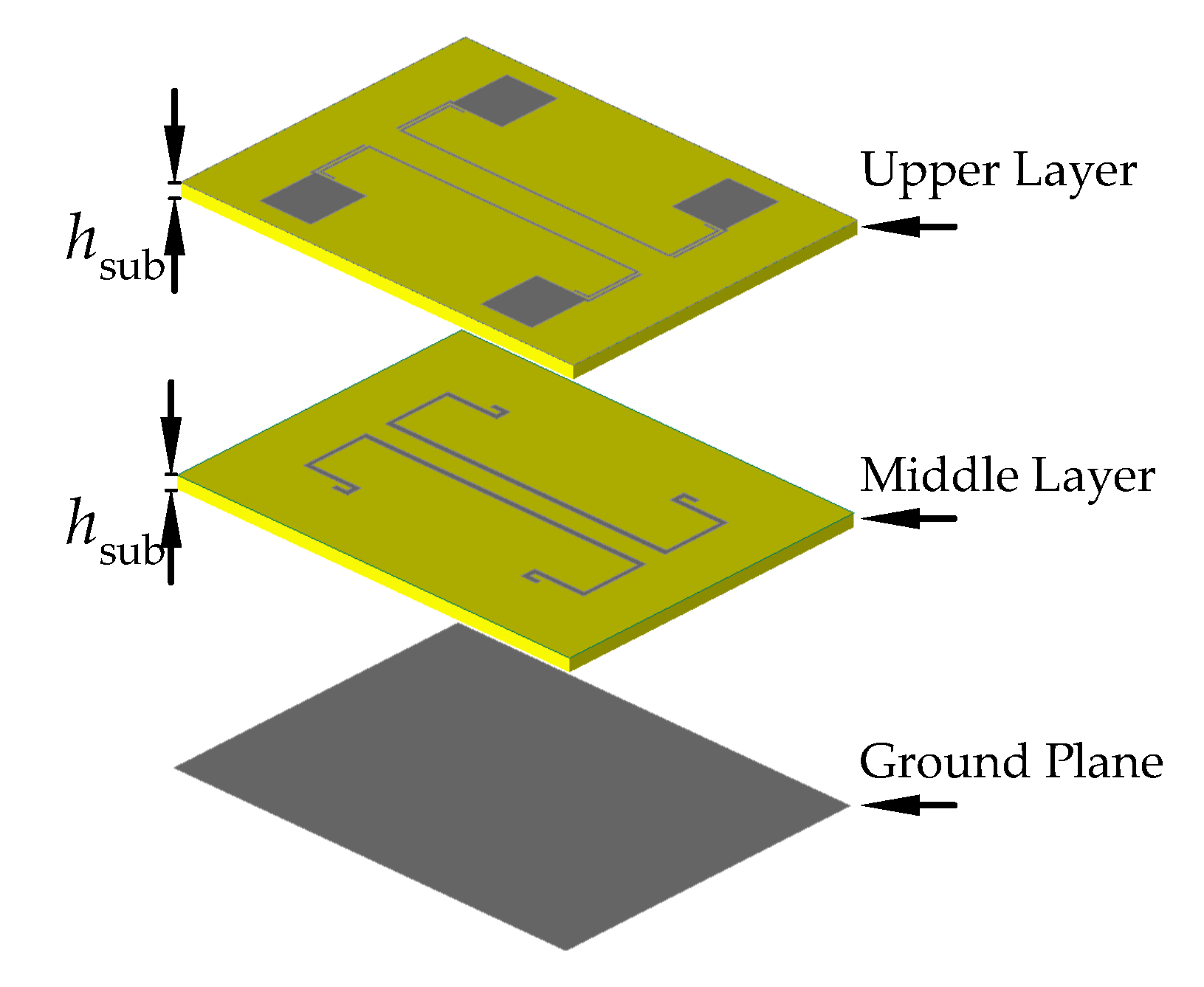
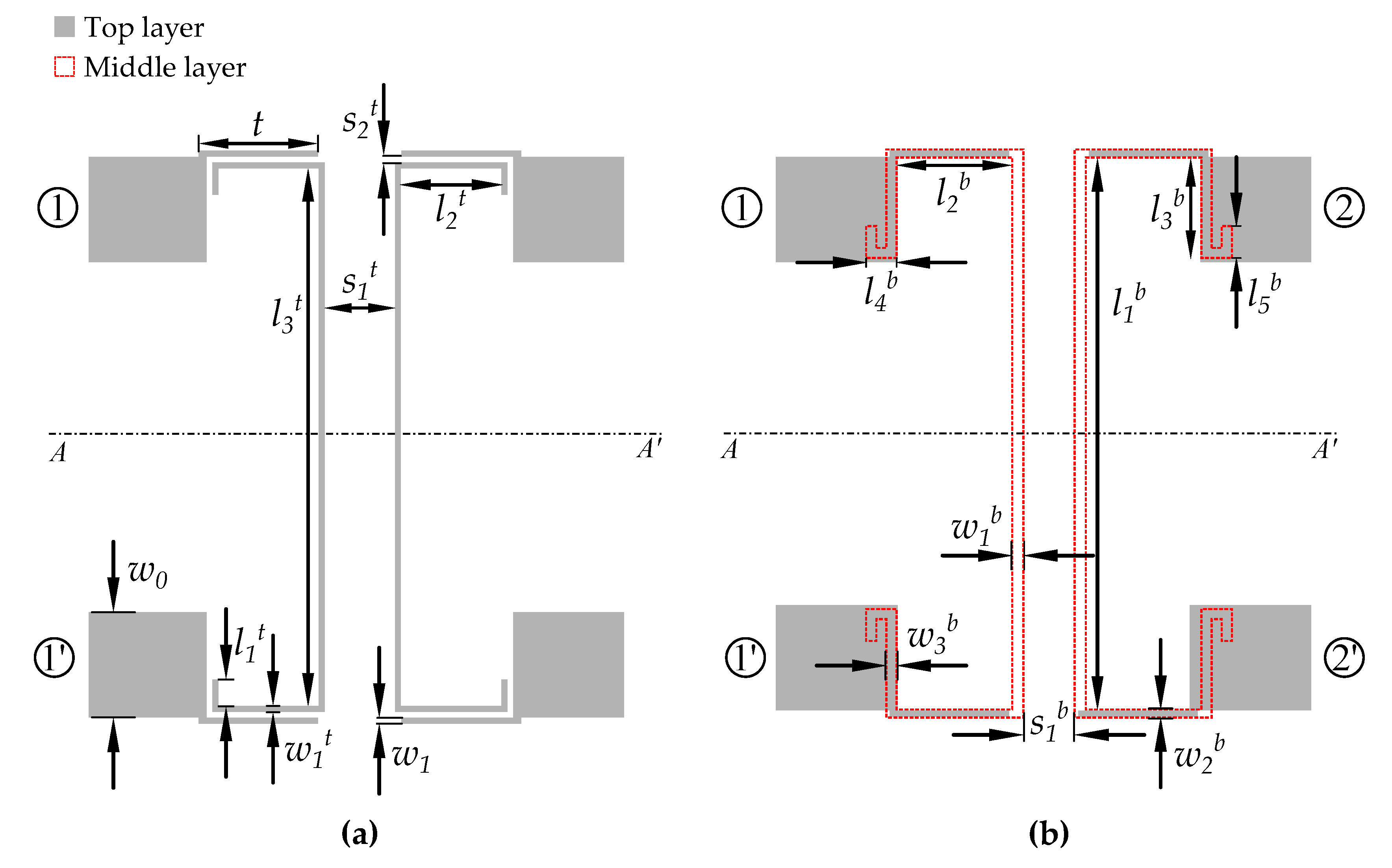

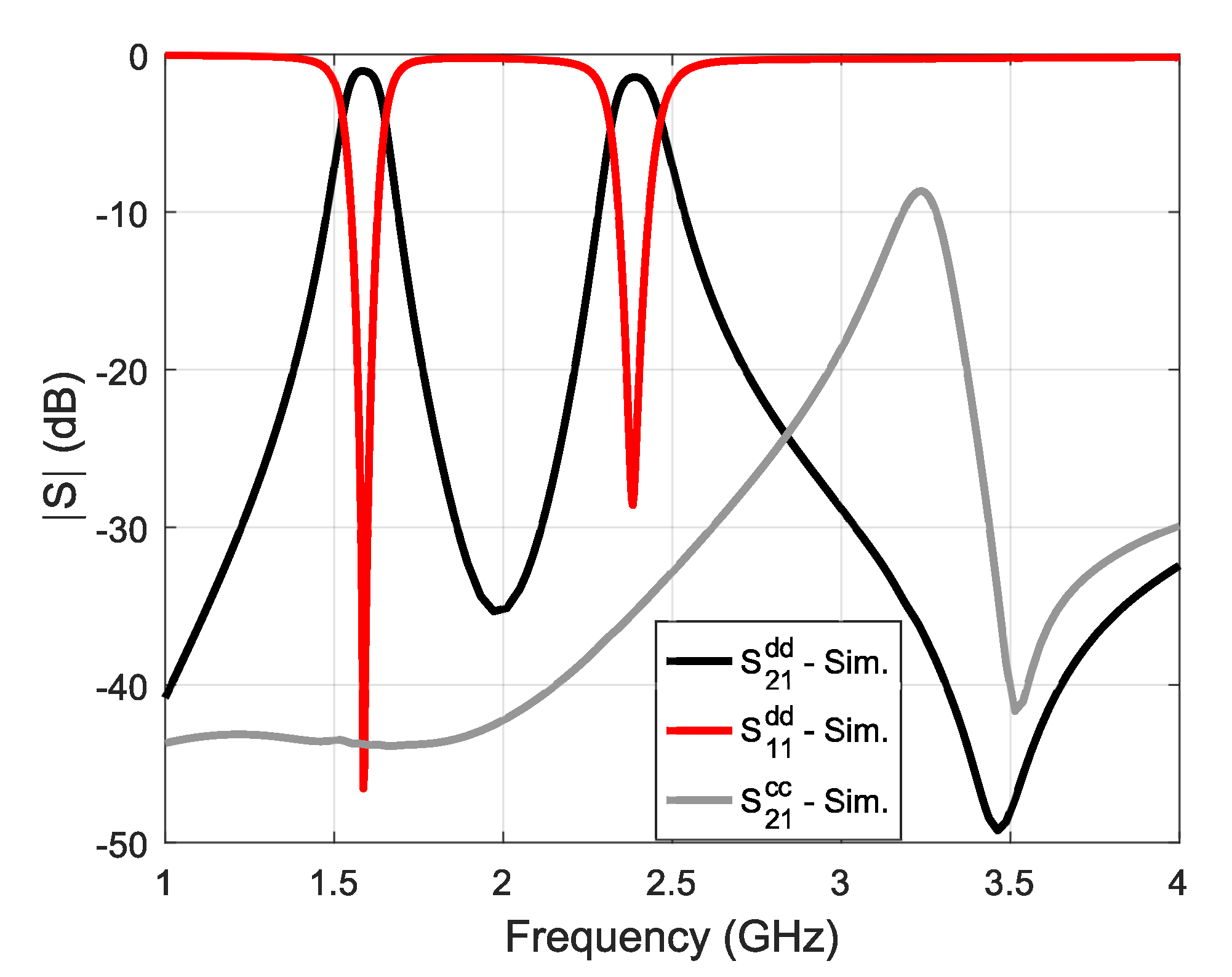
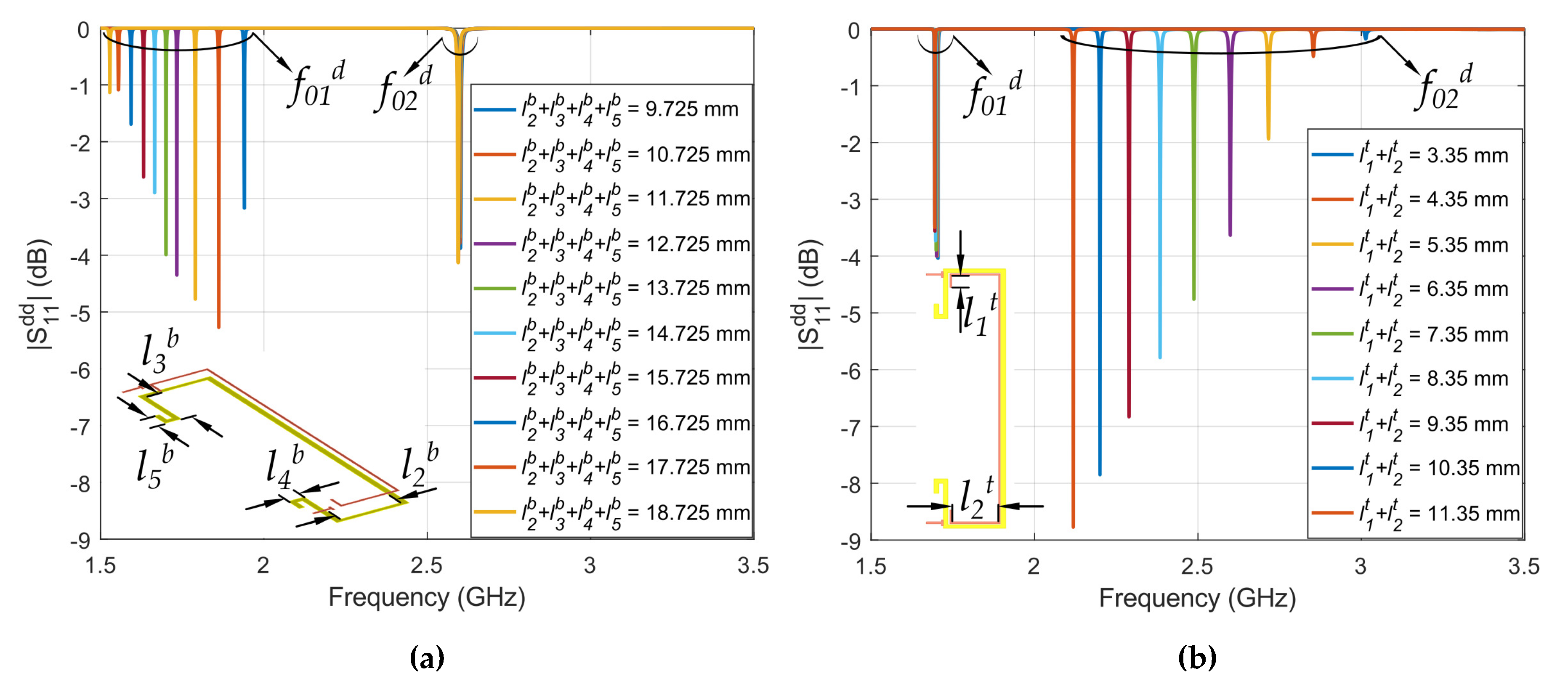
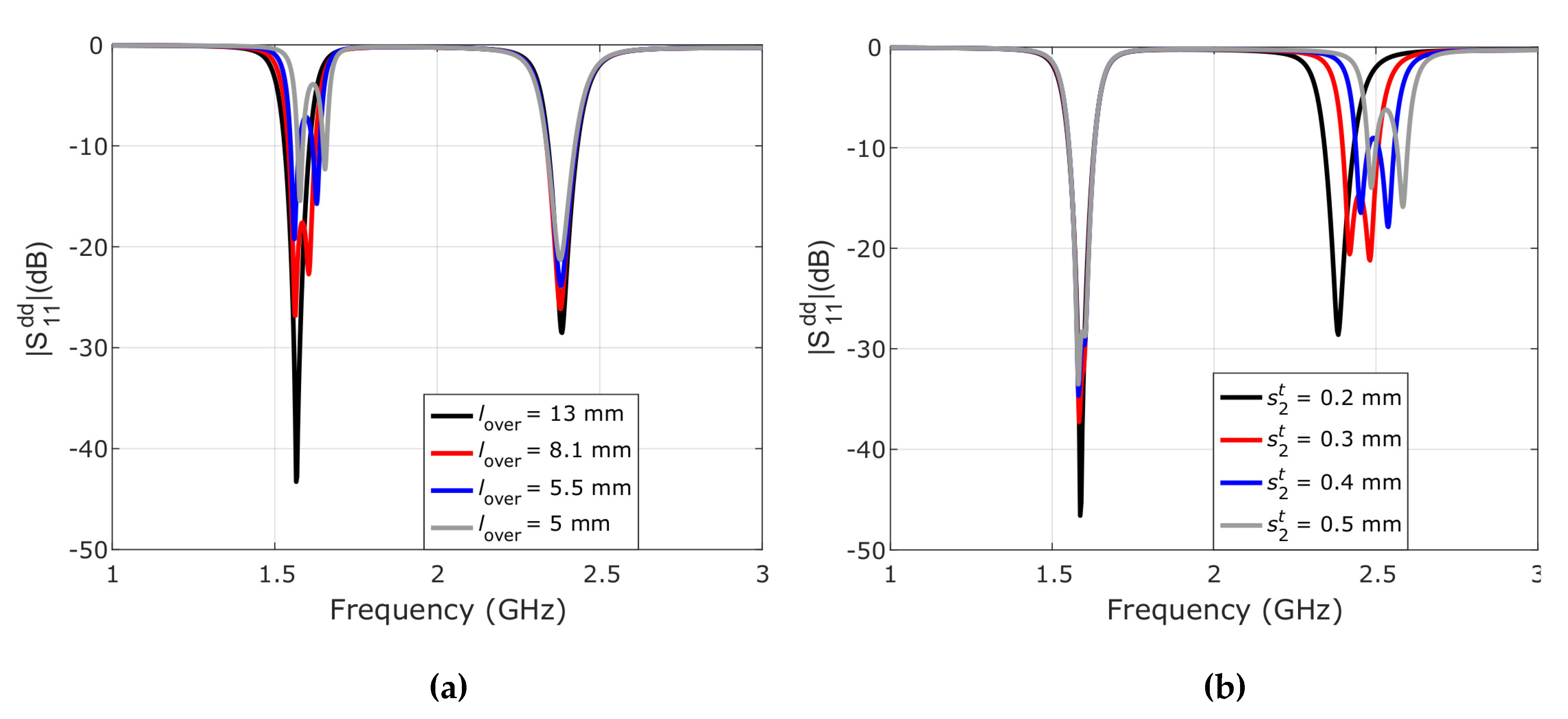
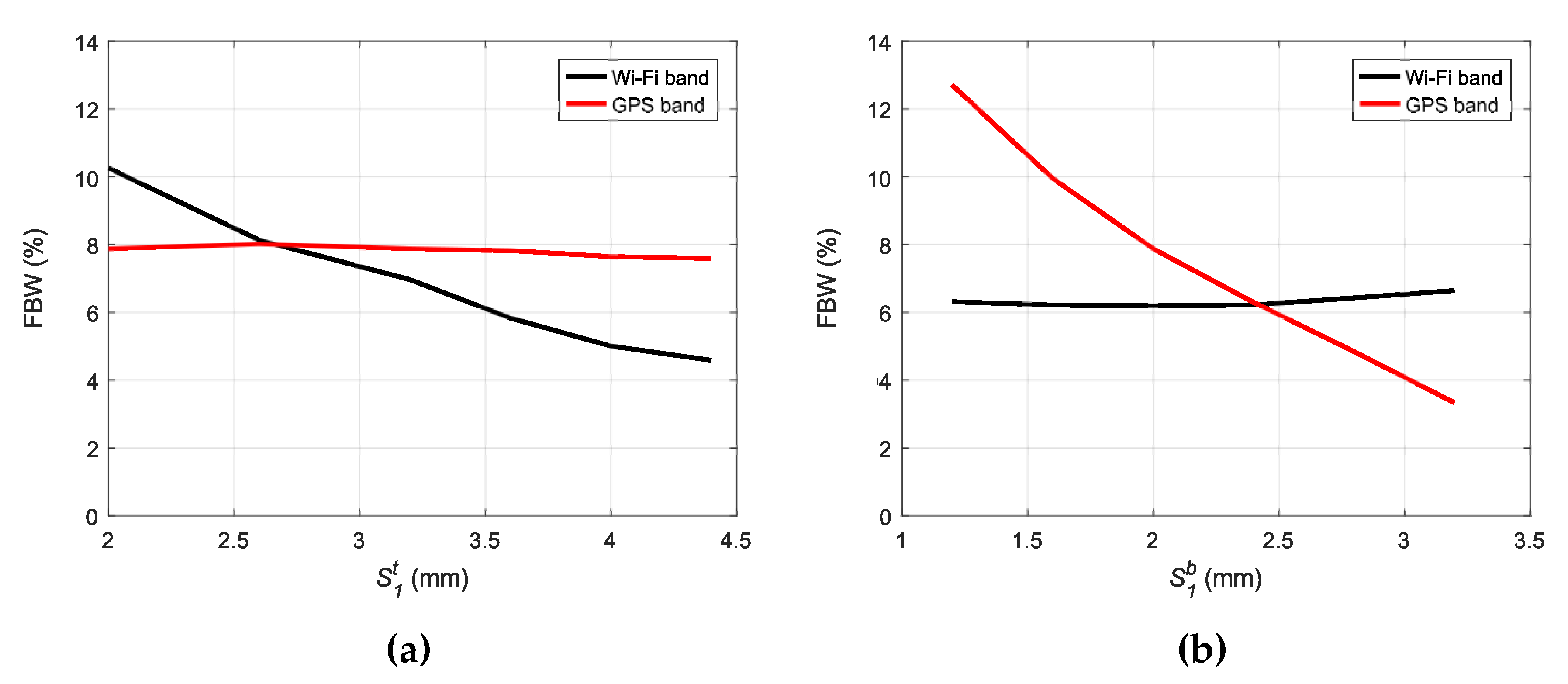
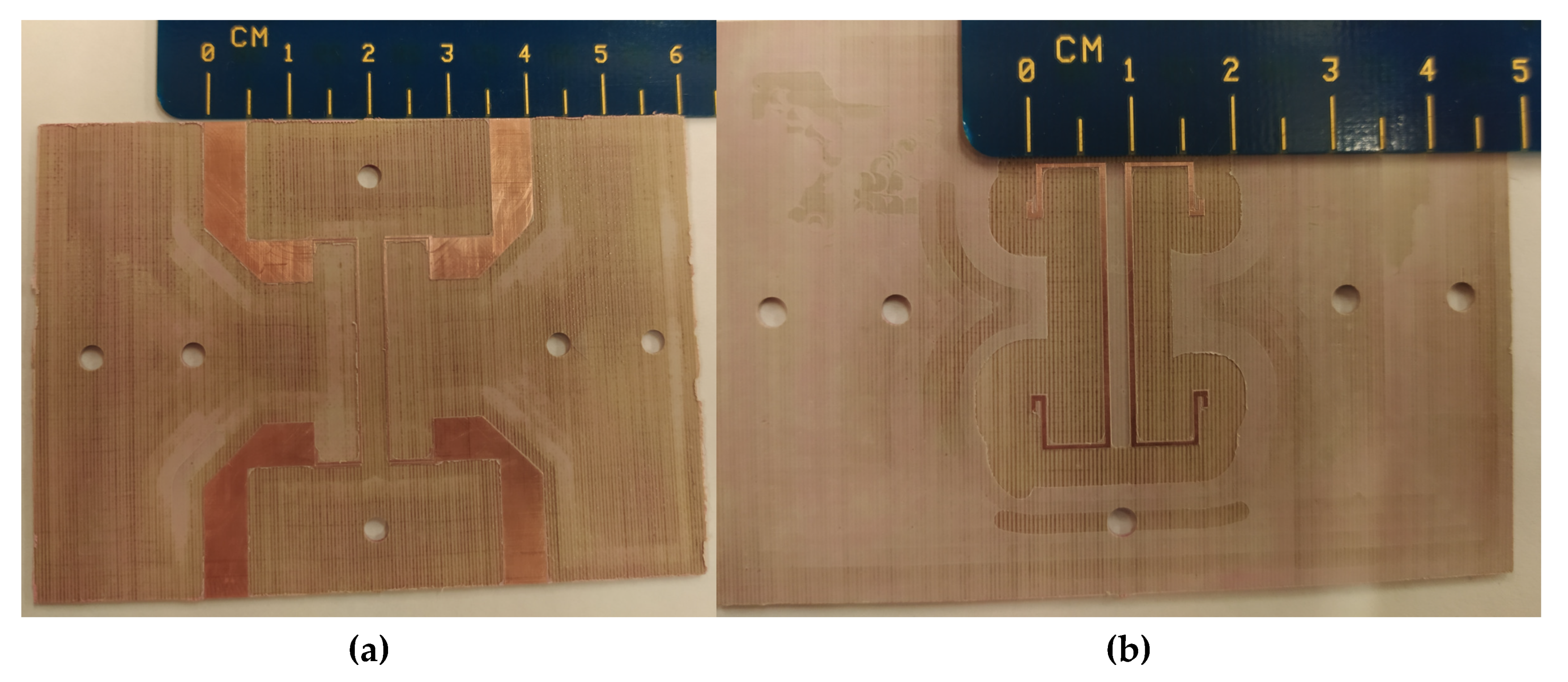
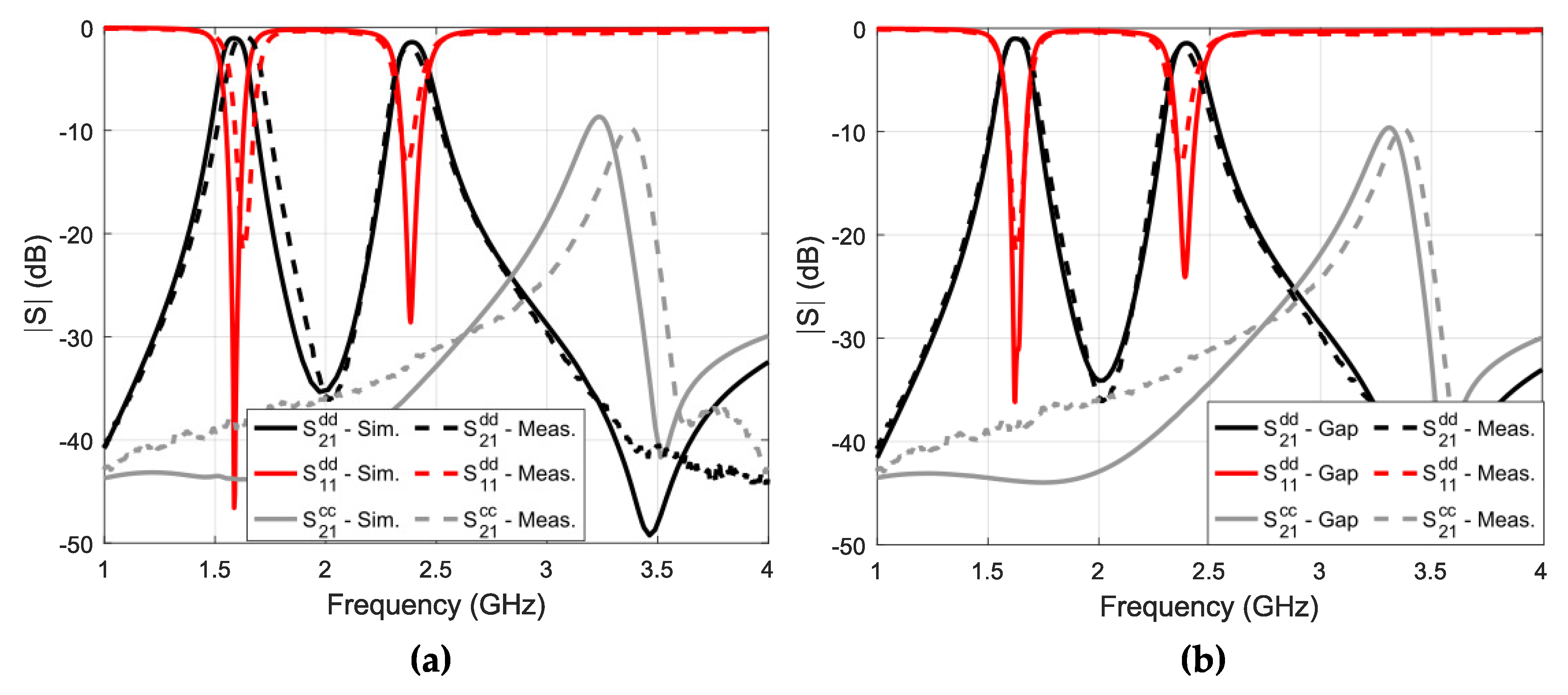
| Ref. | Size * | Differential-Mode | Common-Mode | ||||
|---|---|---|---|---|---|---|---|
| () | 3-dB (%) | IL @(dB) | B-to-B IL > 30 dB | CMRR @(dB) | > 30dB | ||
| [27] | 0.187 × 0.285 | 1.84/2.45 | 9.2/8.2 | 2.2/2.6 | 2–2.3 | 20.5/20 | <30 dB |
| [28] | 0.314 × 0.413 | 2.46/5.56 | 18.7/9.5 | 0.96/1.9 | 3.05–5 | 50/37.5 | Up to 6.75 GHz |
| [29] | N/A | 2.44/5.19 | 18/8.7 | 1.14/2.05 | 3.6–4.1 | 41.26/40.35 | Up to 7 GHz |
| [30] | 0.275 × 0.13 | 2.82/3.21 | 5.2/5.1 | 1.9/1.7 | <30 dB | 13.6/7.8 | 3.2–3.24 GHz |
| [31] | 0.261 × 0.173 | 2.5/5.27 | 11/3.98 | 1.46/2.22 | 3.4/4.8 | 38.5/22.9 | (2–4.5)/(5.3–7.3) GHz |
| [32] | 0.153 × 0.268 | 2.5/5.6 | 5.1/4.8 | 1.29/1.97 | 3.05–4.8 | 34.7/24.1 | 2.3–2.7 GHz |
| [33] | 0.259 × 0.592 | 2.44/5.57 | 16.4/8.62 | 1.78/2.53 | 3.15–4.7 | 36.2/31.1 | (1–5.75)/(6.2–8) GHz |
| [34] | 0.417 × 0.377 | 2.44/5.25 | 8.61/4.57 | 2.4/2.82 | 1.8–3.8 | 52.6/42.2 | Up to 7 GHz |
| [35] | N/A | 1.9/2.8 | 2.1/3.9 | 2.05/2.65 | <30 dB | 40/35.2 | Up to 3.2 GHz |
| [36] | 0.5 × 0.2 | 2.4/3.57 | 8.33/5.6 | 0.87/1.9 | 2.9–3.28 | 24/29.1 | (1.5–2.32)/(2.45–2.9)/ (3–3.6) GHz |
| [37] | 1.23 × 1.23 | 3.5/5.24 | 3.14/3.82 | 1.52/1.65 | 3.7–4.75 | 53.48/48.35 | Up to 6 GHz |
| [38] | 0.67 × 0.32 | 0.9/2.49 | 3.6/2.1 | 2.67/4.65 | 1.1–2.3 | 27.3/35.4 | Up to 4.3 GHz |
| [39] | 0.15 × 0.37 | 2.5/5.8 | 12.9/4.5 | 0.77/1.56 | <30 dB | 41.23/36.44 | (1–3)–(5.8–6.8) GHz |
| [40] | 0.131 × 0.161 | 2.38/3.59 | 1.33/2.13 | 1.34/1.03 | 2.46–3.49 | 48.6/49 | Up to 6 GHz |
| [42] | 0.137 × 0.173 | 2.45/5.6 | 7.35/10.39 | 2.78/2.85 | 3–4.45 | 47.2/30.2 | (1–3.81)/(5.22–7) GHz |
| This work | 0.237 × 0.148 | 1.64/2.37 | 8.86/5.69 | 0.92/1.94 | 1.93–2.13 | 38/31.1 | Up to 2.62 GHz |
© 2020 by the authors. Licensee MDPI, Basel, Switzerland. This article is an open access article distributed under the terms and conditions of the Creative Commons Attribution (CC BY) license (http://creativecommons.org/licenses/by/4.0/).
Share and Cite
Medran del Rio, J.L.; Lujambio, A.; Fernández-Prieto, A.; Martinez-Ros, A.J.; Martel, J.; Medina, F. Multilayered Balanced Dual-Band Bandpass Filter Based on Magnetically Coupled Open-Loop Resonators with Intrinsic Common-Mode Rejection. Appl. Sci. 2020, 10, 3113. https://doi.org/10.3390/app10093113
Medran del Rio JL, Lujambio A, Fernández-Prieto A, Martinez-Ros AJ, Martel J, Medina F. Multilayered Balanced Dual-Band Bandpass Filter Based on Magnetically Coupled Open-Loop Resonators with Intrinsic Common-Mode Rejection. Applied Sciences. 2020; 10(9):3113. https://doi.org/10.3390/app10093113
Chicago/Turabian StyleMedran del Rio, Jose L., Aintzane Lujambio, Armando Fernández-Prieto, Alejandro Javier Martinez-Ros, Jesús Martel, and Francisco Medina. 2020. "Multilayered Balanced Dual-Band Bandpass Filter Based on Magnetically Coupled Open-Loop Resonators with Intrinsic Common-Mode Rejection" Applied Sciences 10, no. 9: 3113. https://doi.org/10.3390/app10093113
APA StyleMedran del Rio, J. L., Lujambio, A., Fernández-Prieto, A., Martinez-Ros, A. J., Martel, J., & Medina, F. (2020). Multilayered Balanced Dual-Band Bandpass Filter Based on Magnetically Coupled Open-Loop Resonators with Intrinsic Common-Mode Rejection. Applied Sciences, 10(9), 3113. https://doi.org/10.3390/app10093113









